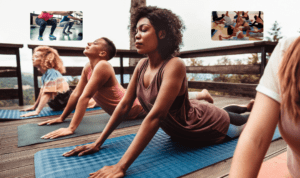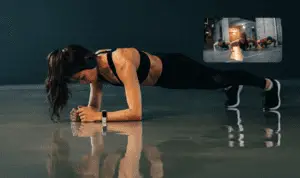When you do yoga as a first timer or you just have recently started practicing the same, you will find out that your stretches will be somehow limited. You will observe and notice difficulty on your part. In this case, yoga blocks may seem significant.
However, those are just initial trades off since before embarking on it, you already know what you are treading into in the first place.
You just have to be determined in pursuing your objective which you have in mind when you started.
As a Beginner
To start your yoga journey, you must have the proper mindset. You should imbibe in your mind that all yoga practitioners, be they in the intermediate or advance level, all started as a novice.
It only depends on their physical attributes at that particular moment, which, to say the least, no two individuals are the same, even on physical capacities and capabilities.
Therefore, you must not be disheartened when you cannot do yet certain poses. Just remember that becoming flexible is a process and will entail consistent stretch practices, which a yoga workout can give, aside from generic stretches.
How to use Yoga Blocks for Beginners?
In initially practicing yoga, you may be asked to perform a fold or bend. Thus, one example of yoga flexes is folding forward.
Nonetheless, it does not matter even if those stretches are backbend, twisting, arm balance, lunges, or certain type of body extensions.
In these particular cases, blocks may be useful and should be, no brainer, utilized, most especially for beginners.
Yoga blocks tend to give stability
You must as well remember that yoga blocks’ usefulness in your workout is that it brings you the floor or ground for you to be able to extend a posture. Yoga blocks give you something to press against.
As we just have said, in yoga, we try to press parts of our body against the floor—our hands and feet, among others.
In forward bend, mostly for beginners, they are having a hard time touching palm face the floor. Yet, yoga blocks do the trick.
Not only touching the ground but, with the blocks, you can definitely press against it and at the same time doing the pose correctly.
Skyscraper Setting
However, blocks come in a variety of sizes: small [low], medium, big [high].
Your choice of the same should depend upon your ability to do the pose properly pressing against the “floor”, meaning with the help of yoga blocks.
This is termed, or known in yoga practice, as the skyscraper technique.
Thus, even with the “small” blocks, if you cannot still do the proper posture, such as pressing against the blocks face palm, then you may want to use the next size, and so on, depending upon your ability to do the appropriate stretches.
Correct Posture with Yoga Blocks Still
Even then, this will still translate to correct posture. As you progress, you will bring with you the attitude of proper pose performance.
Hence, when you are able to firmly grip the blocks flat face palm you are likely doing the pose in a proper manner, compared to only touching the floor with your fingertips.
In this situation, you are now utilizing the absolute control and force of your palm to guide your movements and transitions.
Cheating Myth
The notion that, when employing yoga blocks, you are cheating your pose. It is not true. It is just a myth, a myth that is busted.
Yoga blocks are help and assistance more than ever. They obviate the possibility of injury and help the yogis to execute correct yoga postures.
You can choose the size of the blocks as you wish depending on your ability to flex. Just be reminded that proper resistance experience will also improve your overall execution.
Moreover, if you experience stretching difficulty, your stability and balance will be guaranteed than you will be without blocks.
Accessibility of Yoga Poses
The undeniable benefit of yoga blocks is the newfound accessibility of yoga postures.
For those who have tremendous difficulty in extending their body, arms, and legs to achieve proper execution, yoga blocks provide them the opportunity to perform challenging asanas.
Blocks bring you the ground to assist the body part needed for the flexing pose. Blocks as well give you the balance and stability in the same manner.
Blocks Act as Middle Ground between Difficulty and Proper Postures
Yoga blocks are support tools. Why? They act as the floor or ground for you to be able reach.
While also executing correct poses, with yoga blocks being utilized, you are taking some unwanted tension from your muscles which is prejudicial in early stages of your yoga journey.
Being aware of the anatomy of your body will likewise make you understand he need for blocks.
Child Pose


Although it seems like the Child Pose is easy when you look at it. It goes something like this. You kneel on the mat, then you sit.
You will open your thighs with your knees slowly going apart reaching the width of the mat.
Afterwards, you will sit behind your toes and feet. Your butt then will be resting on your feet now.
Finally, bend forward with your head resting on the mat.
-Child Pose
Normally, this is a beautiful pose. However, there may seem to be issues with respect to beginners or those who are having difficulty in some stretches.
They cannot rest their buttocks totally on their feet, when they try to reach the ground with their head.
Conversely, when they fully rest their behind, they instantly find challenge to touch the floor with their head.
Thus, rather than an effortless posture, it becomes a challenging position. Yoga blocks are, therefore, here to save you from misery. They are the answer.
Now, you can position the block in the middle of your feet and buttocks. The other block, you can place it below your head.
Consequently, while feeling still the stretch, you can now reach the “floor” [yoga block] and you can fully rest your behind onto the other block.
For extra comfort, you may cushion your head with a towel by covering the top of the block.
Seated Bound Angle Pose


One example of the ease of using yoga blocks to break off tension is the Seated Bound Angle Pose [Baddha Konasana].
In this position, your feet are connected and facing each other while your knees are suspended in the air without any support on your legs.
Yet, with yoga blocks placed in each of your thighs, they will immediately ease the tension in your joints because they will now support your legs.
Supported Bridge Pose


As mentioned, yoga blocks act as the “ground” or “floor” to provide pose accessibility or tension releaser.
To reduce pressure from the sacrum [sacral spine], you may opt to place the blocks below your back. This will be a Supported Bridge Pose.
In performing this with the assistance of the yoga blocks, you must have them on your side, while laying down facing the ceiling or sky.
Curl your knees upright with your feet stepping on the mat or floor, hip width apart from each other.
Raise your hips, stomach, and chest off the floor.
Then, grab your blocks and slowly place them below your sacral spine.
You can adjust how many blocks you want to insert, depending on your desired bend.
At this point, you may rest your back onto the blocks and feel the relaxation while being extended.
–Supported Bridge Pose
To return to your original position, raise your hips, put out slowly the blocks by your hands. After being cleared of the blocks below, gradually lower your back until it reaches the ground flat.
While in this supported bridge position, the blocks have your back and you are sting on it.
Final Thoughts
We now have learned, in this brief yet substantial discussion, how yoga blocks work. How do they help yogis in their yoga practice, most especially the beginners.
A yoga workout, while a mind-body exercise, still has to perform physical tasks, such as the asanas or yoga poses. It is in this activity that yoga blocks find importance.
We learned, as well, that the blocks provide accessibility to otherwise challenging poses, and with greater extent, balance and stability.
Nonetheless, as you advance from level to level, it is inevitable that your strength and flexibility will improve, thus, even challenging more your body, to perform and execute the poses without the blocks, which has been your most trusted friend when you started.


